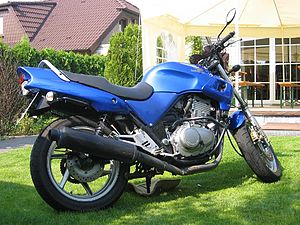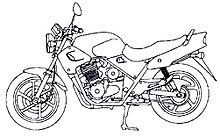Honda CB 500
| Honda (motorcycle) | |
|---|---|

|
|
| CB 500 (PC 26, PC 32) | |
| Manufacturer | Honda |
| Production period | 1993 to 2002 |
| class | motorcycle |
| design type | Naked bike |
| Motor data | |
|
Type : 2-cylinder four-stroke in - line engine , DOHC , four valves per cylinder, bucket tappets, two overhead, chain-driven camshafts, gear-driven balancer shaft, primary drive via gears Cooling : liquid cooling Mixture preparation : Keihin constant pressure carburetor Ø 34 mm Starting system : Electric starter Ignition system : Contactless digital Transistor ignition |
|
| Displacement (cm³) | 499 |
| Power (kW / PS ) | 43/58 at 9,500 rpm according to DIN or 42/57 at 9,500 rpm according to 95/1 EG
32/44 at 6,750 rpm CH |
| Torque ( N m ) | 47 Nm at 8,000 rpm |
| transmission | 6-speed Translation: |
| drive |
Chain drive O-ring chain 108 links RK 525 SMOZ 5 |
| Brakes | Front: single disc brake Ø 296 mm with double-piston caliper from Nissin (PC 26 + PC 32 (1996)), Brembo (PC 32, from model year 1997) Rear: drum brake Ø 160 mm (PC 26 + PC 32 (1996)), single disc brake Ø 240 mm (PC 32, from model year 1997) |
| Wheelbase (mm) | 1430 |
| Dimensions (L × W × H, mm): | 2170 × 720 × 1050 |
| Seat height (cm) | 77.5 |
| Empty weight (kg) | 170 (D), 171 (A, CH) (each dry weight [excluding operating materials]) |
| successor | Honda CBF 500 |
The CB 500 is a naked bike with a two-cylinder engine from the Japanese manufacturer Honda and was built from 1993 to 2002. In 2003 the last machines were sold.
Due to its robustness, the good-natured chassis and the low costs, it is an attractive motorcycle for novice drivers, and it was also popular as a training machine at driving schools. These are meanwhile often switching to the successor model Honda CBF 500 or to other models with ABS .
General
The two-cylinder CB 500 should not use the CB 500 Four , the popular four-cylinder from 1971, or even the rare Honda CB500T , a two-cylinder 1970 on the basis of the 450 K CB be confused.
Competitors for the Honda CB 500 were, for example, the Suzuki GS 500 E or the Kawasaki ER-5
history
The CB 500 was developed by Honda as an affordable mid-range motorcycle. In contrast to other 500s of the 1990s, the CB 500 got an engine that was completely redesigned. In this class, Honda last offered the Honda CB 450 S model , whose engine design (air-cooled OHC two-cylinder with three valves) was based on the CB 400 Twin presented in 1977 .
After the Honda CB 450 S was discontinued in 1990, there was a gap in the Honda range. Those interested in this class opted for competing models such as the Kawasaki GPZ 500 S , Suzuki GS 500 E or the Yamaha XV 535 Virago . That is why the water-cooled CB 500 was developed, not least because of pressure from the German importer.
When it was launched in 1993, it cost 9,260 DM. In the meantime, the price has been raised to 9,660 DM. In the spring of 1996, when production was relocated to Italy, the price was reduced by DM 700 to DM 8,960. The last list price at the end of production was 5,090 euros. Since 1998 Honda has also been offering a sister model called the CB 500 S with half-shell cladding, which had other instruments and mirrors, but was otherwise identical to the CB 500.
Model development and year codes
The motorcycle has a double loop frame made of tubular steel (steering head angle 27 °, caster 113 mm). At the front a telescopic fork (Ø 37 mm, spring travel 130 mm) and at the rear a swing arm with two spring legs (spring travel 117 mm) together with the weight of 193 kg (ready to drive) ensure safe handling .
The PC26 engine of the CB 500 (bore: 73.0 mm, stroke: 59.6 mm, compression: 10.5: 1) was used unchanged in the successor model, the CBF 500, until 2008, but there it was exhaust-gas-cleaned in accordance with Euro 2 using an unregulated catalytic converter and a secondary air system . The CB 500 consumes around 5 l / 100 km of regular gasoline, the tank has a volume of 18 l, of which 2.5 l is reserve.
The year codes are internal designations of Honda and should not be confused with the type names. Likewise, the imprint "PC 26", which can be found on the engine covers of all CB 500 models and the successor CBF 500, regardless of the model code.
CB 500-R (model code PC 26) from 1993 to 1995
- Front disc brake from Nissin
- Rear drum brake
- Silver handbrake and clutch levers
- Fork dip tubes with drain plugs, preload sleeve 20 cm and fork spring length 308.3 mm
- Stanley headlamp insert, metal housing
- Stanley turn signals
- Available in red, green, blue and black
- Manufactured in Japan
CB 500-T (model code PC 32) in 1996
- Special case because technically almost identical to PC 26
- Front disc brake from Nissin
- Rear drum brake
- Fork dip tubes with drain plugs, fork spring length 509.9 mm
- Stanley headlamp insert, metal housing
- Stanley turn signals
- Available in red, green, blue and black
- Made in Italy
CB500-V (model code PC 32) from November 1996
- Front disc brake from Brembo
- Rear disc brake from Brembo
- Black handbrake and clutch levers
- Fork dip tubes without drain plugs, preload sleeve 10 cm and fork spring length 409.1 mm
- Headlight insert from Hella, housing made of plastic
- CEV indicators
- Made in Italy
CB 500-W and CB 500 SW from 1998
- Available in the colors red, yellow, silver and black (from August 1999 also in orange)
- S version: Sports version with half-shell fairing, angular headlights and modified instruments
CB 500-X and CB 500 SX from December 1998
- No changes
CB 500-Y and CB 500 SY from 2000 to 2002
- Shortening of the rear fender (omission of the screwed-on splash guard)
- Matt gray handbrake and clutch levers
- 2000 and 2001: Golden instead of silver cast aluminum rims
- Available in the colors red, metallic blue and black
Model code PC 33
In parallel to the PC 32 series, Honda built a special version of the CB 500 for the Austrian market. This has the model code PC 33 and differs from the PC32 sold in Germany only in that it has a secondary air system , which was required to meet legal requirements.
Power levels
57/58 hp
- Type PC 26 G / PC 32 G
- Chassis number ... PC 26-2 ... or ... PC32A ...
- Motorbike without power limitation
- Top speed 193 km / h
- Power: 43 kW at 9500 min -1
- Standing noise at 4750 min −1 : 86 dB (A)
- Driving noise: 78 dB (A)
- Open intake ports
- 122 main jets
- Carburettor slide springs 16050 MY 5660
- Acceleration / with pillion passenger (0-100 km / h): 5.2 / 6.9 s
- after amendment of the standard from 1998: 42 kW (57 PS)
50 hp
- Type PC 26-2G / PC 32 2G
- Chassis number ... PC 26-3 ... or ... PC32B ...
- Motorbike with power limitation
- Top speed 183 km / h
- Power: 37 kW at 9500 min -1
- Standing noise at 4750 min −1 : 86 dB (A)
- Driving noise: 78 dB (A)
- Changed intake manifold (marking: 37 kW)
- 122 main jets
- Carburettor slide springs 16050 MY 5660
48 hp
- Type PC 26 3G / PC 32 3G
- Chassis number ... PC 26-4 ... or ... PC32C ...
- Motorbike with power limitation
- Top speed 169 km / h
- Power: 35 kW at 8900 min -1
- Standing noise at 4750 min −1 : 83 dB (A)
- Driving noise: 79 dB (A)
- Changed intake manifold (marking: 35 kW)
- 122 main jets
- Carburettor slide springs 16050 MY 5660
34 hp
- Type PC 26 3G / PC 32 3G
- Chassis number ... PC 26-4 ... or ... PC32C ...
- Motorbike with power limitation
- Top speed 158 km / h
- Power: 25 kW at 8500 min -1
- Standing noise at 4750 min −1 : 85 dB (A)
- Driving noise: 76 dB (A)
- Changed intake manifold (marking: 25 kW)
- 125 main jets
- Carburetor slide springs 16050 MY 5710
Performance enhancement kit
In aftermarket one is chip tuning kit for CB available 500, with which the motor can be brought to an output of 60 hp. However, this accessory was only of interest to driving schools until 2016, as the unrestricted A driving license required testing and training on a machine with at least 60 hp. In everyday traffic, an increase of 2 hp is not perceptible due to the design-related variation in performance.
The current regulation of the FeV from 2016 (Appendix 7, point 2.2.1) prescribes a displacement of 600 cm³ and 50 kW or 68 PS for the A test.
In this change, the minimum weight of the vehicle was also increased to 180 kilos. Due to these two changes, the CB 500 is only permitted as a training motorcycle for class A2.
costs
The long service life of the drive was highlighted in the endurance test of the magazine MOTORRAD 04/1996 over 50,000 km; the calculated kilometer costs of the equivalent of 9 cents without and 14 cents with losses in value were among the cheapest values ever determined. The French magazine MOTO REVUE drove 150,000 km with a 1993 CB 500 (PC 26) until 2001. Despite winter, racing and even off-road operation, there were no defects apart from a frame breakage apparently caused by a crash bar. Mileage well over 100,000 km are also known from private ownership. Today, used vehicles are usually traded between 1000 and 2000 euros, depending on their condition and mileage, particularly well-preserved two-wheelers with accessories also fetch prices above 2000 euros.
literature
- Joachim Kuch: Type compass Honda motorcycles since 1970 , 1st edition, Motorbuch Verlag, Stuttgart 2000, ISBN 3-613-02061-0
Web links
- cb500.net - German-language CB 500 fansite with extensive information and exploded views
- cb500-wiki.de - German-language CB 500 Wiki
- 50,000 km endurance test
- 150,000 km endurance test German (PDF; 28 kB)
- Honda Press Packs from 1998


